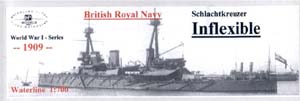HP Models' 1/700 HMS Inflexible |  | History The Invincible-Class battlecruisers, like the HMS Dreadnought, were the brainchild of Britain's visionary First Sea Lord Jackie Fisher. They were the logical development of the armored cruiser and were designed to carry the same large caliber weapons as the new battleships of the British fleet. However, they would retain the same lightness of armor that characterized cruisers so that they could become, with their speed, the "greyhounds" of the fleet, according to Fisher. The theory was that they could run down and destroy lesser-armed enemies, while outrunning any adversaries that could penetrate their armor. When used as they were designed, they performed spectacularly – running down and destroying a German cruiser raiding force at the Battle of the Falkland Islands in November 1914. But when they were put in the line of battle and had to withstand salvoes of large caliber shells, the result was tragic. At Jutland in May 1915, three battlecruisers (including HMS Invincible) were lost when large caliber shells apparently penetrated their magazines. The Kit I had wanted an HMS Invincible, but my favorite on-line ship model supplier, Pacific Front hobbies, only had kits for Inflexible and Indomitable in stock. Thinking it would be easy to convert one of the sisters into Invincible, I ordered the Inflexible. The kit came in a box filled with Styrofoam peanuts and all the parts packed in bubble wrap sleeves. From a thorough examination of the parts compared with drawings of the class I found in three sources, it appears that the kit can only made into HMS Invincible at the time of the Falklands battle. Good news for me because that is exactly what I wanted, but the box says "HMS Inflexible, 1909." Both the Invincible and Indomitable kits are listed in catalogs as 1909. I would hazard a guess that either there was a mix up on my box or that all the kits depict Invincible in 1914. The hull piece is 9 7/8 inches long and nicely cast with no pits or bubbles. The deck planking and fittings are nicely done. Seven resin wafers with 101 parts make up the rest of the kit – there are no brass or white metal parts included. These parts are well cast, but I found a bubble pit on two of the turrets. This will be easily fixed with filler. The gun barrels are cast separate from the turrets and will require some sanding to clean up the seam lines. The bulkheads on the superstructure are thin and the detailing is crisp. Although resin parts are included for the tripod fore and main masts, these should be used as templates to replace them with brass rod. The instructions are printed single-sided on three 8‡ by 11î sheets of white paper. Other than the company logo, the name of the ship and the words "British Royal Navy," the writing is all in German. The largest number of words is used to describe the lengths of various masts and yards and therefore can be easily discerned. The first sheet has black and white side and top views of the Invincible-class as they were in 1909; the second sheet an exploded view of the assembly; and the third sheet a diagram of how to assemble the main mast. There's a fourth sheet of green paper that is printed entirely in German and begins with "Wichtig! Wichtig!' According to some attempts to translate it using Alta Vista, it appears to be a description of how to straighten a warped hull. Because the kit is representative of Invincible in 1914, it does not include parts for the torpedo nets and booms, which were a prominent part of the class profile in 1909. Conclusion After adding some aftermarket photoetched rails and ladders and replacing the resin masts with brass rod, craftsmen should be able to build a very nice-looking model of HMS Invincible in 1914. If HP Models is indeed using the 1914 version of Invincible for all three of the ships in the class, modelers who wish to have representatives of the other ships (or of Invincible at an earlier date) will need to do some scratch building. The bridge areas of the two other ships were substantially different. The most significant difference in profile during World War I was a taller fore funnel for Inflexible and Indomitable. | 








|